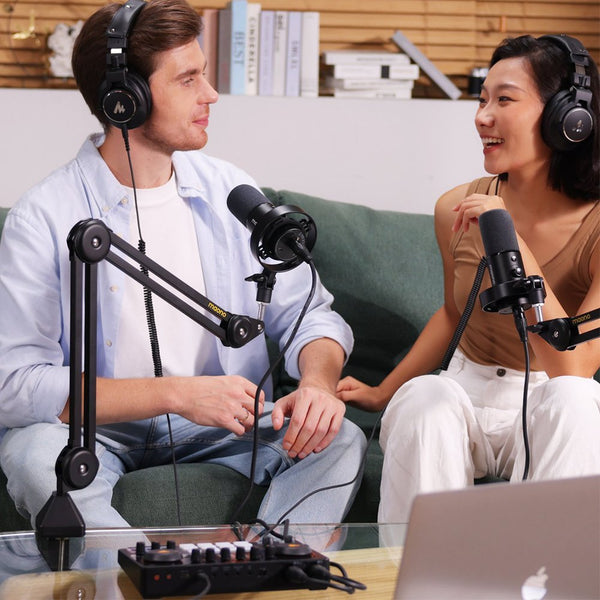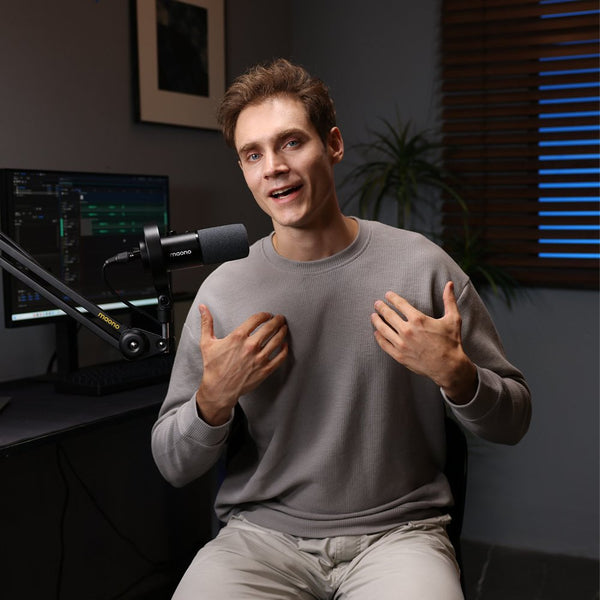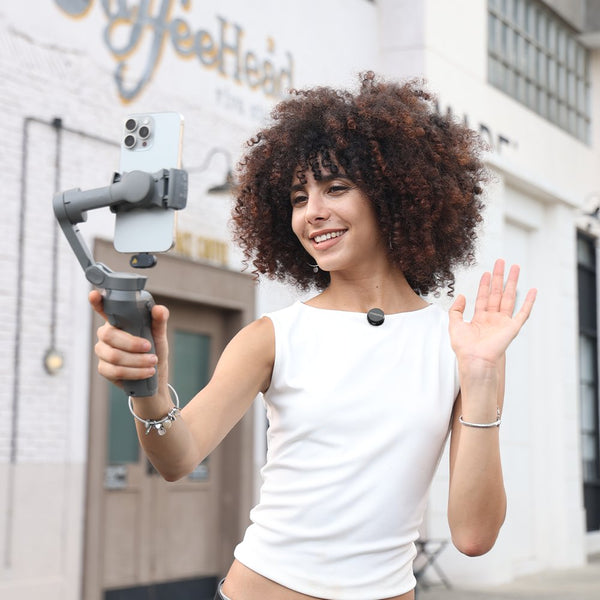Are you excited to share your favorite dishes and recipes through vlogging? You should be—trying out new dishes from time to time keeps your audience engaged. It’s also much more enticing to listen to instructions from a chef or cooking vlogger when the audio is clear, not muffled or echoey. This is possible when the content creator uses a reliable wireless microphone like the Maono Wave T5 or the Maono Wave T1 Mini.
If you’ve ever tried recording a cooking vlog, you know how challenging it can be to maintain great visuals and great sound while moving around the kitchen. You’re chopping, sizzling, blending—and talking to the camera all at once. One of the biggest hurdles creators face is capturing clear, consistent audio. This is where microphone system wireless solutions come in handy.

Why Wireless Microphones Are a Game-Changer for Cooking Videos
Cooking videos rely not just on visuals, but on crystal-clear instructions. Without clear audio, your viewers may miss key steps—or worse, lose interest entirely. That’s why a microphone lavalier setup, especially a wireless one, is essential for kitchen vloggers. These mics allow you to move freely, avoid getting tangled in cords, and still deliver crisp audio despite noisy kitchen environments.
Whether you’re sautéing on the stovetop or reaching into the oven, a wireless microphone for iPhone or Android ensures your voice stays front and center—making your vlogs more professional and enjoyable.
How to Vlog Your Favorite Recipes with a Wireless Mic Setup
Cooking vlogs are more engaging when you can talk your audience through each step in real time. A cordless mic system clips discreetly to your shirt and transmits audio to your camera or phone—no matter where you move.
Here’s a quick setup guide:
-
Clip the mic to your collar, apron, or inside your shirt—near your mouth but not rubbing against fabric.
-
Plug the receiver into your smartphone or camera.
-
Sync audio levels before filming.
-
Test by moving around the kitchen while speaking naturally.
This setup allows you to cook hands-free while recording detailed, uninterrupted narration.
The Best Wireless Lavalier Mics for Kitchen Vlogging
Maono Wave T5 Wireless Lavalier Microphone
This wireless Lavalier microphone is a favorite for food vloggers because of its ease of use and reliable performance.
Top Features:
-
Built-in noise reduction and voice enhancement
-
Dual-transmitter receiver—ideal for two-person setups
-
USB-C and Lightning adapters included
-
Long-range signal (up to 300m/1,000ft)
-
Lightweight and portable
Why it’s great:
The Maono Wave T5 ensures your voice stays sharp even over sizzling pans or blender noise. It’s perfect for mobile vloggers who want to shoot and upload from their phone without extra audio syncing steps. It’s especially effective as a wireless mic for iPhone setups thanks to its plug-and-play compatibility.
Maono Wave T1 Mini Wireless Microphone

If you’re just starting out or need a compact solution, the Maono Wave T1 Mini wireless microphone is a fantastic choice.
Top Features:
-
Plug-and-play wireless system
-
Compact clip-on mic with noise cancellation
-
Compatible with iPhones and Android
-
Affordable yet professional-grade sound
Why it’s great:
The Maono Wave T1 Mini is ideal for quick setup in small kitchen spaces. Despite its size, it delivers a punch in sound quality and makes your cooking tutorials sound clean and professional—an excellent wireless microphone for iPhone users as well.
Tips for Shooting Cooking Videos Solo Without Sacrificing Sound
Vlogging solo in a kitchen has its hurdles—but audio shouldn’t be one. Here’s how to maintain sound quality:
-
Face the mic while speaking when possible.
-
Minimize loud background noises by turning off appliances not in use.
-
Record B-roll separately (e.g., frying, blending) to avoid overlapping loud audio.
-
Use a wireless Lavalier mic positioned just under your chin for optimal pickup.
Wireless lav mics allow you to focus on your food without being tied to a boom mic or external recorder.
How to Sync Wireless Audio with Recipe Video Footage
Many microphone system wireless setups can record directly into your smartphone or camera, reducing the need to sync audio separately. But if you’re recording audio externally:
-
Use a clap or slate at the start for easy syncing.
-
Import both audio and video tracks into your editing software.
-
Use auto-sync features in tools like Adobe Premiere Pro, Final Cut Pro, or DaVinci Resolve.
Syncing ensures your narration matches your hand movements and visual instructions—keeping your tutorial smooth and professional.
Frequently Asked Questions
1. How do I set up a wireless mic in my kitchen?
Connect the mic to yourself, the receiver to your camera or phone, and do a test recording. Keep the receiver close and away from metal or thick walls.
2. Where should I place the mic when I’m cooking and moving around?
Use a wireless Lavalier mic clipped to your chest or apron, about 6–8 inches below your chin.
3. Can wireless mics pick up my voice clearly over kitchen sounds?
Yes, especially models with noise reduction like the Maono Wave T5. They isolate your voice from background noise.
4. What’s the difference between a lapel mic and a headset mic for food vlogging?
Lapel mics, like a microphone lavalier, are more discreet and convenient for vlogging; headset mics provide more consistent sound but can be bulkier.
5. How do I avoid audio dropouts with wireless microphones?
Keep a clear line of sight between the mic and receiver, and stay within the recommended range (usually 50–100 feet).
6. Do I need a receiver or audio interface for my wireless mic?
Most wireless lav mics like the Wave T1 Mini come with plug-and-play receivers that work with phones and cameras—no audio interface needed.
7. How far can I move from the camera with a wireless mic?
You can typically move up to 1000 feet (300 meters), depending on the environment and microphone system wireless specs.
8. How do I record recipe instructions while cooking in real time?
Use a cordless mic system, and narrate naturally as you cook. Keep your mic positioned well and reduce background noise where possible.
9. Should I narrate live while cooking or add voiceovers later?
Narrating live saves editing time and feels more authentic. Voiceovers offer more control—choose based on your comfort and style.
10. How do I film overhead shots and still capture good audio?
Use a wireless Lavalier microphone so your audio stays clear regardless of camera angle
11. How do I edit out background noise like sizzling or boiling?
Use noise reduction tools in editing software or choose mics with built-in filters. The Wave T5 and T1 Mini have built-in features to help with this.
12. What kind of lighting works best in a kitchen vlog?
Natural light is best. Supplement with soft LED panels or ring lights to avoid harsh shadows. Light your face and workspace evenly.
13. Do I need a second mic if I’m cooking with someone else?
Yes. Use a dual-channel cordless mic system like the Maono Wave T5 for two-person vlogs to avoid awkward audio gaps.
14. What types of recipes work best for vlogging?
Quick, visual recipes like pasta, desserts, smoothies, or one-pan meals perform well. Choose something colorful and easy to follow.
For example: tuna pasta, broccoli with garlic and tofu, mango kani salad, etc.
15. How do I make my cooking vlogs more engaging?
Tell a story, inject humor, talk through your thoughts while cooking, and keep energy high. Use good lighting and audio to keep it professional.
16. How long should a cooking vlog be to keep viewers interested?
8–15 minutes is ideal for full recipes. For shorts or teasers, aim for under 60 seconds.
17. Should I include full ingredient lists and steps on-screen?
Yes. Include them visually or in the video description for reference. Viewers appreciate clarity and easy-to-follow content.
18. What camera and mic setup do most successful cooking YouTubers use?
Many use mirrorless or DSLR cameras with external wireless Lavalier microphones for mobility and sound clarity.
19. How can I record cooking tutorials without a professional studio?
Use your home kitchen! All you need is good light, a decent camera (even a phone), and a wireless microphone for iPhone like the Maono Wave T1 Mini.
Final Thoughts
Your cooking vlog doesn’t need a fancy studio to impress viewers—it needs passion, consistency, and clear, compelling audio. The best way to ensure your audience hears every instruction, story, or tasty tip is to invest in a wireless Lavalier microphone.
Both the Maono Wave T5 and Maono Wave T1 Mini are excellent choices for creators at any level. They’re lightweight, budget-friendly, and designed with video content creation in mind—especially in fast-paced environments like your kitchen.
From syncing audio to editing out background sizzles, the right cordless mic system can transform your casual cooking vlog into a pro-level production. So clip it on, preheat your oven, and press record—your next viral recipe is just a few steps (and a few great sounds) away.



